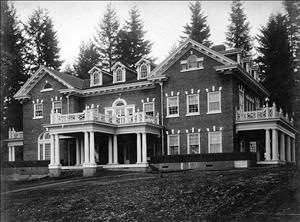On August 1, 1908, the cornerstone of the governor's mansion in Olympia is laid in a ceremony conducted by the Masonic Grand Lodge of the State of Washington. Royal A. Gove (1856-1951), Most Worshipful Grand Master, presides, together with State Treasurer George G. Mills. A copy of the program, a roster of state officials, copies of Olympia and Tacoma newspapers, and an Olympia Booster Book are among the items sealed within the cornerstone, which is made of Washington marble. Governor Albert E. Mead (1861-1913) witnesses the ceremony, along with several hundred other celebrants.
Felicitous Speeches
The Seattle Post-Intelligencer reported on August 3, 1908:
"In the shady grove overlooking the Sound in the old territorial capitol grounds where the mansion is to be built the citizens of Olympia and quite a few visitors from out of town witnessed the Masonic services of the laying of the corner stone and applauded the felicitous speeches. The event was treated as a half holiday in Olympia, many of the leading stores closing up during the hours of the services. The corner stone was laid under the auspices of the Masonic Grand Lodge of the state of Washington, with Most Worshipful Grand Master Royal A. Gove conducting the services. A number of other grand lodge officers were present, but the places of the absentees were filled by prominent local [Olympia] Masons ... . The basement and foundation of the mansion has been practically completed, the corner stone ... was placed in the northwest corner of the building at the main entrance. A Masonic inscription on the face gives the date of its laying ... . George G. Mills, state treasurer and member of the building commission having charge of the erection of the mansion, presided during the exercises” (Seattle Post-Intelligencer).
The governor’s mansion was built on a 12-acre tract of land donated by Edmund Sylvester (1821-1887) and accepted by the Territorial Legislature in 1855 for a state capitol. It was designed by architects Russell and Babcock of Tacoma in Georgian Revival style, built under the supervision of general contractors Matthew Dow Construction, and decorated by Weissenborn & Company, both of Seattle. Washington firms performed all the work, operating on a short budget of $35,000 and within a short time frame of five months. The building was accepted by the State Building Commission on December 18, 1908, in time for the Alaska-Yukon-Pacific Exposition, Washington's first world's fair, which opened in Seattle on June 1, 1909.
Cornerstone Ceremonies and Other Good Works
The Masonic cornerstone-laying ceremony is hundreds of years old and remains, along with funerals, one of the few Masonic rites conducted in the public eye. It was common for officials to request such a ceremony for public buildings, following the example of President George Washington (1732-1799), who oversaw Masonic dedications of the U.S. Capitol Building and the President’s House (White House). Most of the officials of the state of Washington during this period were Masons. Governors Albert Mead and Marion E. Hay (1865-1933) belonged, as did Samuel Goodlove Cosgrove (1847-1909), who died in office after serving as governor for a single day. State Treasurer George A. Mills, state Senator Alfred Smith Ruth (1865-1915), U.S. Senator Levi Ankeny (1844-1929), and state Senators Francis Willington Cushman (1867-1909) and William Ewart Humphrey (1862-1934), were also Masons.
The Most Worshipful Grand Master Royal A. Gove was a physician in Tacoma. As Grand Master, he advocated for the creation of the Masonic Retirement Center at a time when there was no social security system, health insurance, or any other form of public assistance for the aged. In the early days of Washington Territory, the Masons established cemeteries in many localities, and built many Masonic Halls.
One Governor, Then Another
Governor Mead, who had supported development of the governor’s mansion, lost the primary election of 1908. Samuel Cosgrove, also a Republican, won the primary and was elected governor. Cosgrove was taken ill immediately after the final vote and went to California to recover, returning only long enough to be inaugurated. A housewarming was planned for the new governor and his family on January 28, 1909, the day after the inauguration, but Governor Cosgrove left immediately after being sworn in to return to California. His wife, Zephorina Edgerton Cosgrove (ca. 1859-1949), and son, E. E. Cosgrove, attended the gala housewarming. Cosgrove died in California on March 28, 1909. The new mansion would not be inhabited by his successor, Lieutenant Governor Hay, until May of that year.
The Hays had five children when Marion Hay became governor, and additional rooms were completed in the attic of the new mansion to house the large family. Lizzie Muir Hay (1865-1943), the new first lady, began to order furnishings in May 1909. When the family first moved in, the women of Olympia loaned them furniture and other household items so that the Hays could properly entertain visitors expected for the A-Y-P Exposition.
For the First Family, the year 1909 proved to be a difficult one. The Hay’s eldest daughter became ill with scarlet fever, and the family was quarantined until she recovered, causing them to miss the opening of the exposition. Nonetheless, by the end of 1909 the governor’s mansion was completed and fully furnished. With a brief interruption for major renovations in the mid-1970s, it has served as the official residence of every governor ever since.

